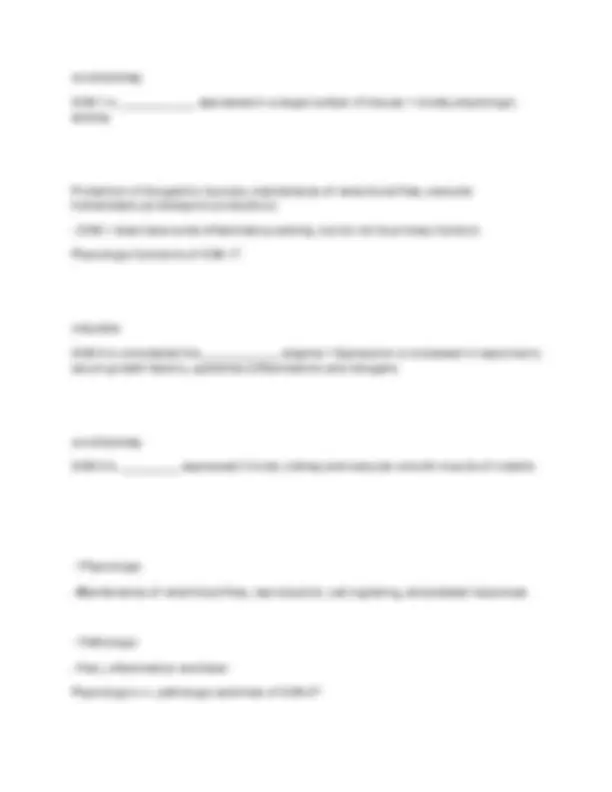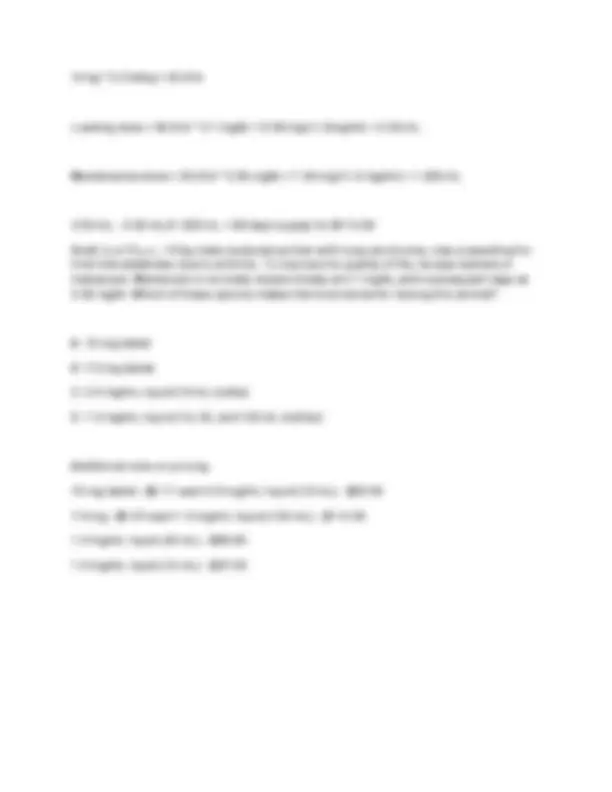










Study with the several resources on Docsity

Earn points by helping other students or get them with a premium plan


Prepare for your exams
Study with the several resources on Docsity

Earn points to download
Earn points by helping other students or get them with a premium plan
Community
Ask the community for help and clear up your study doubts
Discover the best universities in your country according to Docsity users
Free resources
Download our free guides on studying techniques, anxiety management strategies, and thesis advice from Docsity tutors
VMED 5223 NSAIDs EXAM WITH 100% VERIFIED SOLUTIONS!!
Typology: Exams
1 / 14

This page cannot be seen from the preview
Don't miss anything!









Non-steroidal anti-inflammatory drugs (NSAIDs) What drugs are: Non-narcotic and provide the following activities: vAnalgesic vAnti-inflammatory vAnti-pyretic
Based on a specific enzyme and eicosanoid metabolites affected How are NSAIDs classified?
Pain & inflammation from osteoarthritis, surgery and trauma Why do we use NSAIDs?
Advantages of NSAIDs over other narcotic analgesics?
Prostaglandins & leukotrienes What inflammatory compounds cause hyperalgesia = pain response to stimuli that do not normally induce pain (In other words, lowers the pain threshold)?
nociceptive Prostaglandins and leukotrienes help magnify ________________ transmission to the spinal cord and act a local mediators of inflammation
Describe the cyclooxygenase pathway?
Binding pocket in COX-2 enzyme is wider - Substitution of a Valine for an Isoleucine in COX-1 creates a change in protein confirmation to make the binding pocket more narrow.
COX-_____inhibitors act by blocking the binding pocket
◦Exception: Aspirin acetylates the binding pocket = irreversible inhibition
larger COX-2 inhibitors are structurally __________ than nonselective inhibitors
narrow Nonselective COX inhibitors are conformationally more __________
**For some NSAIDs, R enantiomer has some activity. What are NSAIDs of the 2-proprionic acid class (which enantiomer has more activity, usually sold in racemic mixtures)?
greater Common misconception: COX-2 inhibitors exhibit ___________ inhibition of COX-2 = Actually, they inhibit COX-2 at high levels while either not inhibiting COX-1 or inhibiting COX-1 at low levels.
Large number
Small number
Greater COX-
selectivity
How does increasing the IC50 ratio of COX-1/COX-2 impact the COX-2 selectivity?***
Not memorization = just know how to compare
Other considerations:
A selective inhibitor, preferential for COX-
Clotting issues = so far except for unusal circumstances, don't develop
GI, renal and hepatic toxicities
What are some NSAIDs like asprin and acetaminophen harmful to cats?
NSAID recommendations in cats NSAID recommendations in cats
What are mechanisms through which NSAIDs can cause renal toxicity?
◦Uncommon in dogs receiving NSAIDs.
Carprofen What NSAID:
◦ COX-2 selective inhibitor, but effects may be due to PLA2 inhibition also (2 hit mechanism)***
◦ Acute and chronic pain
◦ Osteoarthritis
◦ Perioperative analgesia
Administered every 12 or 24h in dogs. Single dose but not repeated dosing in cats.
Meloxicam What NSAID:
◦ Preferential COX-2 inhibitor.
◦ Soft-tissue or musculoskeletal pain, including osteoarthritis in dogs. ◦ Perioperative pain for orthopedic or soft tissue surgeries.
◦ Can use for short term (1 day) treatment of cats.
◦ Half life is 24h - once daily dosing.
Firocoxib What NSAID: ◦ Preferential COX-2 inhibitor.
◦ Soft-tissue or musculoskeletal pain, including osteoarthritis in dogs.
◦ Perioperative pain for orthopedic or soft tissue surgeries.
◦ Can use for short term (1 day) treatment of cats. ◦ Half life is 24h - once daily dosing.
Robenacoxib What NSAID:
◦ Preferential COX-2 inhibitor. Appears to be relatively selective for COX-2 in dogs and cats.
◦ Approved for use in cats (US, up to 3 d).
Librela What is a monoclonal antibody against NGF (inflammatory mediator), degenerative myelitis may be a possible side effect?
Dogs
Cats
Common NSAIDs used in clinics for dogs and cats?
Say you pick - D 100 mL bottle
14 kg * 2.2 lb/kg = 30.8 lb
Loading dose = 30.8 lb * 0.1 mg/lb = 3.08 mg/ (1.5mg/ml) = 2.05 mL
Maintenance dose = 30.8 lb * 0.05 mg/lb = 1.54 mg/ (1.5 mg/ml) = 1.025 mL
(100 mL - 2.05 mL)/1.025 mL = 98 days supply for $112. Noah is a 12 y.o., 14 kg male neutered pointer with lung carcinoma, now presenting for hind limb weakness due to arthritis. To improve his quality of life, he was started on meloxicam. Meloxicam is normally dosed initially at 0.1 mg/lb, with subsequent days at 0.05 mg/lb. Which of these options makes the most sense for dosing this animal?
A. 15 mg tablet B. 7.5 mg tablet C. 0.5 mg/mL liquid (15 mL bottle) D. 1.5 mg/mL liquid (10, 32, and 100 mL bottles)
Additional note on pricing: 15 mg tablet - $0.11 each 0.5 mg/mL liquid (15 mL) - $39. 7.5 mg - $0.07 each 1.5 mg/mL liquid (100 mL) - $112. 1.5 mg/mL liquid (32 mL) - $58. 1.5 mg/mL liquid (10 mL) - $37.